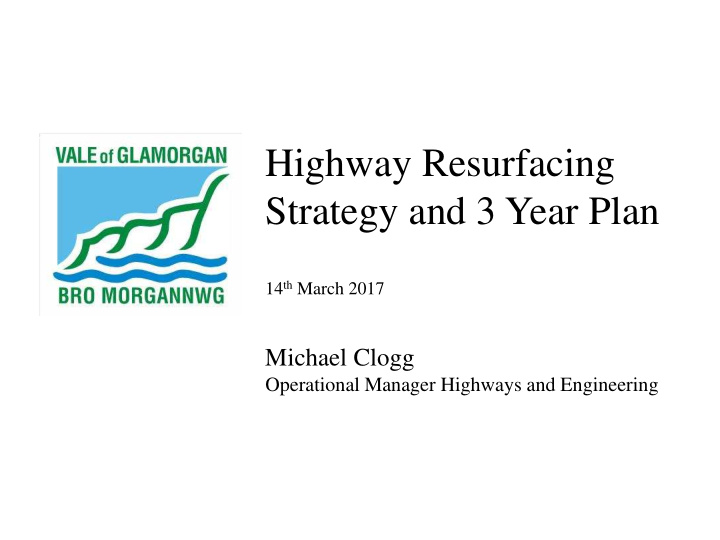



Highway Resurfacing Strategy and 3 Year Plan 14 th March 2017 Michael Clogg Operational Manager Highways and Engineering
Background and Context • The Local Highway Network is a significant Council Asset • Used by Public, Business & Visitors and vital to economic and transportation needs of the Vale • The Council has some 1,067km of road comprising A, B, C Class roads as well as unclassified roads
Highway Maintenance Responsibilities • Statutory Function to maintain the highway under Section 41 of the Highways Act 1980 • Reactive Maintenance in accordance with Code of Practice for highway Maintenance Management and Council’s Highway Safety inspection Manual • Planned Maintenance programme derived from 3 year plan and essential part to maintaining our road network for longer
The 3 year Plan • ‘ Carriageway Surface Prioritisation Scoring System’ considers 8 criteria (see next slide) • The criteria is assessed to provide a weighted score out of 400 indicating priority for capital expenditure • Targets capital expenditure where it is most effective and needed to prolong an assets life
Carriageway Resurfacing Prioritisation Scoring System Column Description Key Data Factor Maximum Score A Road classification A Road 30 B Road 25 C Road 20 Unclassified/Rural 15 30 B Scanner Survey Data Red 50 Yellow 30 Green 0 50 V1 – No defects C Visual Assessment 0 V2 – Cracking 10 V3 – Defects present 20 V4 – Multiple Defects 50 V5- Unserviceable 80 80 D Engineers Assessment 0 to 80 80 80 E Third Party Claims 1 0 (last 3 years) 2 20 3 or more 30 30 F ONE VALE complaints 1 10 2 20 3 or more 30 30 G Bus routes 20 20 H Maintenance Costs (over one Under £1000 0 year) £1000>£3000 40 Over £3000 80 80 Theorectional Maximum is 400
Maintenance Methods • Asset management - it is important to select the right method at the right time to get best value for money • Resurfacing – involves planing off all or some of the existing surface; adjusting manholes and gullies; apply tack coat; and lay new surface course to line and level • Surface Dressing – potholes or other defects repaired prior to spraying the existing road surface with hot bitumen which is then covered with stone chippings • Micro Asphalt – two coat process, the first fills minor imperfections / undulations and the second coat provides final surface
Resurfacing • Used where the road surface profile or drainage is generally poor • Various specifications available depending on traffic flows / turning movements • Selection of aggregates, binders and PSV available
Surface Dressing • Generally used on busy rural or urban roads (> 40mph) to provide more grip and seal surface from water ingress • Potholes and other defects fixed and the surface made level • The existing road surface is sprayed with an adhesive layer of hot bitumen. • Chippings are rolled into the bitumen to form a water-resistant protective layer which makes the road less slippery and extends its life • Works are carried out in summer months • Vehicles using the new surface help to embed the loose chippings • The road is swept to remove any chippings that have not been pressed into the bitumen and appropriate road markings added
Micro Asphalt • Generally used on urban roads and lasts up to 10 years • Any faults fixed including potholes filled • Comprises mixture of bitumen, small aggregate & cement • First coat fills imperfections and undulations • Second coat provides final sealed surface and texture of road
Typical Costs • Resurfacing works on average £16m2 • Micro Asphalt is approx. £4.10m2 • Surface dressing is approx. £5.10m2 • Surface dressing and Micro Asphalt most cost effective if carried out at appropriate time
Works Completed 16/17 • Total budget available this FY £1.48m • Resurfacing - 25 roads at cost of £1.1m • Surface dressing - 4 roads at cost of £160k • Micro Asphalt – 31 roads at cost of £220k
Summary Position • Effective Asset Management requires lower cost preventative treatments • To maintain steady state of road condition requires some £2.06m budget annually • Reactive maintenance essential to reduce the incidents of third party claims • Strategy long-term corrective treatments rather than patch repairs
Thank you for listening & Any questions
Recommend
More recommend